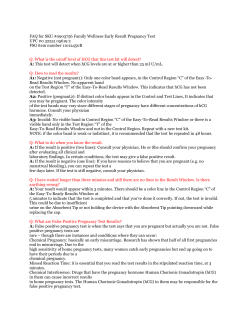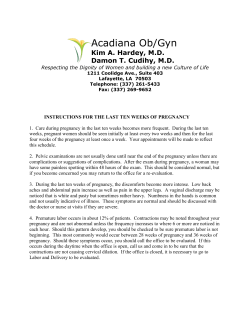
Obstetric Pearls for the Primary Care Practitioner Objectives
Objectives Obstetric Pearls for the Primary Care Practitioner z z Pamela Schmagel, MD Rushmore OB/GYN z z Body Water Metabolism z Chronic volume overload – active sodium and water retention – – z Total body water increases 6-8 liters – – – z changes in osmoregulation renin-angiotensin system z z Osmoregulation z z z increased maternal weight hemodilution of pregnancy elevation of maternal cardiac output Significant physiologic changes occur in the cardiovascular system during pregnancy. These are usually well tolerated in healthy young women however certain cardiac disorders increase concerns for morbidity and mortality. Shortly after conception plasma volume expands Osmotic threshold is reset for antidiuretic hormone and thirst Increase water intake and urinary volume – – Blood volume increases by about 1.5 liters Cardiovascular System Understand normal physiologic changes of pregnancy Recognize the diagnosis and treatment of common medical conditions of pregnancy Discuss obstetrical emergencies requiring intervention Understand pharmaceutical classifications of medications used in pregnancy Transient polydipsia and polyuria during weeks 5 to 8 Increase in sodium retention but less than increase in total body water Heart z z z Displaced to left and upward due to anatomical changes of pregnancy May increase size of cardiac silhouette on chest x-ray Mild myocardial hypertrophy due to expanded blood volume 1 Cardiac Output z z z z z z Cardiac output increases by 30-50% The initial increase occurs by 5 weeks gestation 40% increase by 12 weeks Peak is between 25-30 weeks Increased cardiac output mostly directed to uterus, placenta and breasts Stroke volume and heart rate increase to contribute to increased cardiac output Supine Hypotension Syndrome z z z z z z Pallor Sweating Nausea Vomiting Lightheaded/dizzy Fetal heart rate changes Supine Hypotension Syndrome z z z z z Blood Pressure z z z z Normal Changes that Mimic Heart Disease z – – – z z z BP = Cardiac Output x systemic vascular resistence BP decreased in pregnancy due to decrease in SVR Increase in BP greater than pre-pregnancy values is not normal Nadir occurs during second trimester Normal Changes that Mimic Heart Disease Dyspnea – z Supine position Enlarged uterus compresses the inferior vena cava Reduces venous return to the heart and therefore reduces cardiac ouput IVC can be completely occluded in late pregnancy Not a concern prior to 24 weeks Most prior to 20 weeks Usually does not worsen Does not occur at rest Does not preclude normal activities Decreased exercise tolerance Fatigue Syncope Chest discomfort z z z z z Peripheral edema Mild tachycardia JVD after 20 weeks Systolic ejection murmur Third heart sound 2 Findings Not Associated with Normal Pregnancy Respiratory System z z z z z Hemoptysis Syncope or chest pain with exertion Progressive orthopnea Paroxysmal nocturnal dyspnea Lung Changes z z z z Elevation of diaphragm decreases lung volume Functional residual capacity ( expiratory reserve volume and residual volume) decrease Inspiratory capacity increases No change in vital capacity z z z Spirometry and peak flowmeters are unchanged and can be used in managing respiratory illnesses Chronic hyperventilation due to increase in tidal volume and minute ventilation Respiratory rate does not change Mild respiratory alkalosis Urinary System – z Hematocrit decreases during gestation Usually not less than 30% Hypercoagulable state – – Increase in levels of procoagulant factors Decrease in fibrinolytic system Gastrointestinal System z Urinary frequency and urgency Increased GFR (decrease in BUN and Creatinine) Treat UTI for 10 days. Send culture Maternal plasma volume increases 50% RBC volume increases 18-30% – z – z z Right ureteral dilation greater than right Mild h hydronephrosis d h i iis normall May cause flank pain if significant – z z Kidneys and ureters increase in size – z z Hematologic Changes z z z Increased nasal stuffiness due to hyperemic and edematous changes in mucosa of nasopharynx and increased secretion of mucus Epistaxis Chronic cold symptoms but try to avoid chronic use of nasal decongestants z Increase in appetite Decrease lower esophageal sphincter Decreased tone and motility of GI tract z z z z Need additional 300 kcal/day Heartburn Constipation Nausea/Vomiting 3 Breasts z z z z Tenderness and heavy feeling by 4 weeks after LMP Rapidly enlarge during the first 8 weeks of pregnancy due to vascular engorgement Progressive change due to ductal growth and alveolar hypertrophy Nipples enlarge and areolae enlarge and darken Skin Changes z z Increased hirsutism Normal increase in scalp p hair loss 2-4 months after delivery – z Reassure resolution after 6-12 months – – z Most are treated as the non-pregnant patient Special attention to certain medications that may affect fetus Avoid surgical interventions if condition is expected to resolved after delivery Hyperpigmentation – – – Melasma or chloasma Linea nigra Increase in size and number of nevi The Eye z Increased thickness of cornea z Decreased intraocular pressure z – z z Due to edema Noted by 10 weeks gestation – – Stretch marks Creams of no benefit Color fades but mark remains Common Medical Conditons of Pregnancy z z Striae Gravidarum – z Skin Changes Improvement in preexisting glaucoma Avoid expensive changes in eye glass or contact lens prescriptions No change to visual fields Consider elevated blood pressure with complaints of scotomata Headaches z z z z z z z z Increased in first and third trimester Increase in hormones and blood volume C ff i withdrawal Caffeine ithd l Hypoglycemia Fatigue and lack of sleep Sinus congestion and allergies Prepregnancy migraines usually decrease Consider preeclampsia 4 Headaches z z z z z Decrease stress Improve posture Check vision Increase hydration and sleep Avoid – z ASA, NSAID, ergotamine, Triptans Short course of narcotics Morning Sickness z z z z z z z Usually resolves by 16th week Small frequent meals Dry crackers prior to getting out of bed Avoid triggers Acupressure wristbands Vitamin B6 Phenergan, Compazine, Reglan, Zofran Low Back Pain z z z z z z Due to shift in gravity and lordosis of pregnancy Hormonal changes causing relaxation in joints Improve posture and support Appropriate shoes Tylenol, heating pad massage Chiropractic care and physical therapy Heartburn z z z z z z z Worse in second and third trimesters Small frequent q meals Avoid lying down after eating Avoid certain foods Antacids H2 blockers Proton pump inhibitors Carpal Tunnel z z Pain, numbness, tingling of wrist and fingers Pressure on median nerve – – z z z z Overuse Increased edema Decrease use Elevate arms when lying down Wrist Splints Avoid surgery unless doesn’t resolve Constipation and Hemorrhoids z z z z z z z Increase fluids Dietary changes to increase fiber Regular bowel habits Exercise Stool softeners Avoid straining Analgesic and steroid ointments 5 Yeast Infection z z z z z Increased estrogen and glucose in vaginal discharge White, cottage-cheese discharge Pruritis Antifungal vaginal cream Fluconazole Pruritic Urticarial Papules and Plaques of Pregnancy z z z z z z z Terms of Pregnancy z z z z z z Gravida – pregnant woman Gravida 1/primagravida - 1st pregnancy Para – birth past age of viability or 20 wks Para 0 or nullipara – no pregnancies past 20 weeks Para 1 or primipara – one pregnancy past 20 weeks Multipara – 2 or more births past 20 weeks Benign dermatosis Late 3rd trimester or postpartum Usually 1st pregnancy Severe itching Unknown cause Self limited Antipruritics, emollients, steroids Terms of Pregnancy z z Multiple births count as only one para Stillbirths past 20 weeks count as one para TPAL Obstetrical Emergencies zT z --------------------Term zP P---------------------Preterm Preterm z A---------------------Abortions z L---------------------Living z All female patients of reproductive age are pregnant until proven otherwise All pregnant patients have an ectopic pregnancy until proven otherwise 6 First Trimester Bleeding z Threatened abortion – – – – z Spontaneous ab Inevitable ab Incomplete ab Complete ab Ectopic pregnancy z Serum hCG positive 5 days after conception z Normal pregnancy DOUBLES Q 48 hours, therefore draw serially z 5-6wks = 1000 = gestational sac on TVUS z Max: 100,000 at 10 10--12 wks Third Trimester Bleeding z Placental abruption Ectopic Pregnancy z z z z Preeclampsia z z z z Placenta Previa Work up for ectopic pregnancy Urine hCG If positive obtain TVUS and quantitative hCG Tubal mass or no IUP with quant >1000-2000 z z z Systolic BP greater than 140 Diastolic BP greater than 90 Proteinuria (Edema) Severe BP >160/110 HELLP syndrome – Classification of Medications z Almost all medications cross placenta – z z z z Exceptions Heparin and Insulin Usually prescribe as you would for the non nonpregnant patient with some exceptions Risk factors assigned based on risk to fetus Definitions based on FDA Do not refer to breast feeding risk Hemolysis (LDH >600), Elevated Liver enzymes (AST >70), Low Platelets (<100K) Risk Factor Categories z z z z z A – Controlled studies show no risk B – No evidence of risk in humans C – Risk cannot be ruled out D – Positive evidence of risk X – Contraindicated in pregnancy 7 Drugs Contraindicated z z z z z z z Isotretinoin Misoprostol Methotrexate Warfarin Ergotamines ACE inhibitors Nitroprusside z z z z z Quinolones Tetracyclines NSAIDS Antiepileptic drugs Streptomycin, Kanamycin 8
© Copyright 2025





















